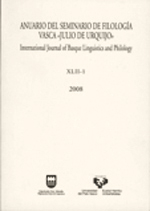An overview of theories of the syntax-phonology interface
##plugins.themes.bootstrap3.article.main##
##plugins.themes.bootstrap3.article.sidebar##
Argitaratua
2008-04-14
Gorka Elordieta
Laburpena
This article is intended as a critical survey of the phonological theories of the syntax-phonology interface. These theories can be divided into two main groups, according to the role they attribute to syntactic representations in creating phonological domains. On the one hand there is the Direct Reference Theory, which claims that phonological operations are directly sensitive to syntactic information, in terms of relations of c-command or m-command (i.e., government) holding between the elements participating in phonological processes. On the other, there is the Prosodic Hierarchy Theory of Prosodic Phonology, which defends the view that syntactic and phonological representations are not isomorphic and that there is a distinct level of representation called Prosodic Structure which contains a hierarchically organized set of prosodic constituents. These constituents are built from syntactic structure by a finite set of parameterized algorithms, and phonological processes refer to prosodic constituents rather than to syntactic constituents. Elordieta (1997, 1999) proposes that certain phonological phenomena may be specified to apply in the domains or constituents formed by functional and lexical heads related by feature checking. Seidl's (2001) Minimal Indirect Reference Theory claims that syntactic relationships such as theta-domains determine phonological constituency at the phrasal level. Another important, more recent view is the one that maintains that spellout domains (that is, all the material included in a syntactic phase except for the head of the phase and elements in the specifier of that phase) are interpreted as phonological constituents in PF.
Nola aipatu
Elordieta, Gorka. 2008. «An Overview of Theories of the Syntax-Phonology Interface». Anuario Del Seminario De Filología Vasca "Julio De Urquijo" 42 (1):209-86. https://doi.org/10.1387/asju.2309.
##plugins.themes.bootstrap3.article.details##
Zenbakia
Atala
Artikuluak
Lan hau Creative Commons Aitortu-EzKomertziala-LanEratorririkGabe 4.0 Nazioartekoa lizentzia baten mende dago.


